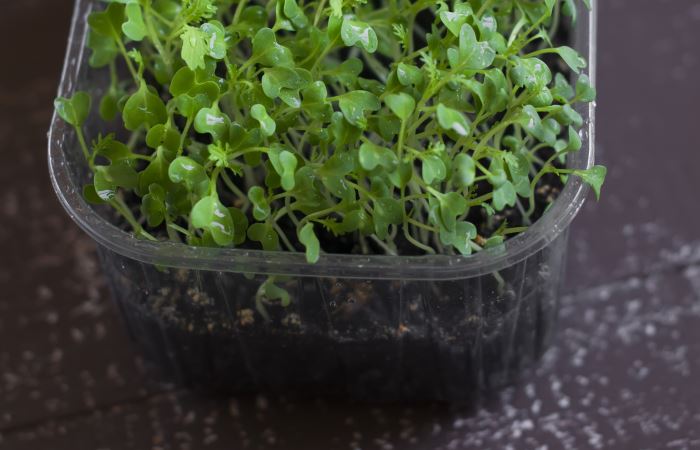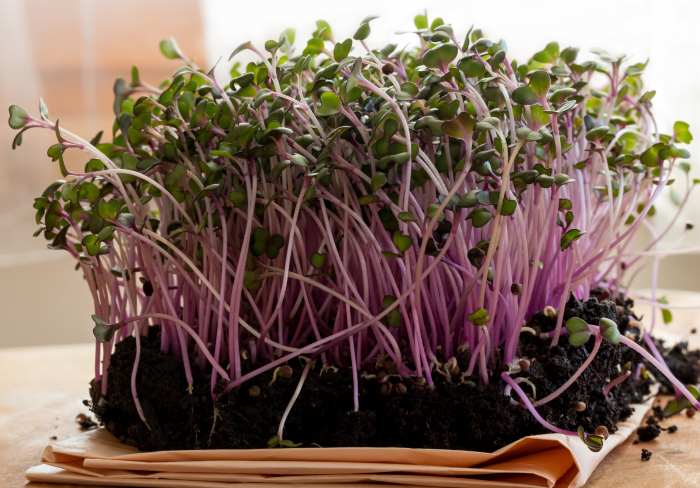Do you love microgreens, but find them too expensive to purchase at the store?
If you’re an avid gardener like I am, you may consider growing microgreens at home. The steps to a DIY microgreen crop are relatively basic, but you may wonder if you need special soil to grow the seeds.

The answer is yes if you want to produce a healthy crop of the best microgreens.
But don’t worry. I list all the information about the top five growing mediums for microgreens right here in this article, so you can quickly learn all about them.
1. Organic Potting Soil

Soil is the most common base for microgreen seeds of any size. Don’t use just any soil. You want an organic potting soil. This type of soil offers nutrients, which means your seeds will grow strong with no need for additional fertilizer.
Before you grab that old bag from the shed, check out our article does potting soil go bad?
The other important benefit of organic potting soil is that it’s very sterile. For indoor plants, like microgreens, you want to eliminate pests in the soil that can harm the seedlings or get into your home.
Happy Frog is a soil many growers mention as a favorite for texture, moisture-retention, sterility, nutrient levels, and great-looking crops of microgreens.
For those who have homemade compost, you can mix some with standard soil if it’s more convenient than store-bought soil. You must take the time to sterilize the soil first before planting your seeds.
Fortunately, the process is quite simple, preheat the oven to 180-degrees Fahrenheit (82-degrees Celcius) and pop a tray of soil into the oven and let it bake for 30 minutes to kill off any pests.
While an excellent growing medium, soil is messy, especially when working with it indoors.
2. 100% Natural Coconut Coir
Coir is the fiber found between the outside of a coconut and the seed inside.
Coir is a top choice for growing microgreens for its amazing ability to hold water, yet not retain so much that it kills tender plants.
The material is also very affordable, lightweight, and expands quite a bit when in water, so a little goes a long way.
Coconut coir comes in blocks that are dehydrated and compressed, so it’s simple to store until you start a new tray of microgreens or sprouts. You can also buy coir in thin, easy-to-handle sheets, which you roll out and trim to the size of your growing tray.
Coconut coir has many benefits, like a fine texture, which allows proper aeration and room for seeds to grow. Water distributes evenly through the fibers, so every seed has exposure.
While coir has a near-neutral pH balance, it doesn’t provide many natural nutrients for your microgreens. Many growers use fertilizer in the water they add to their growing trays when using coconut coir as a growing medium.
3. Hydroponic Growing Mats

Hydroponic growing mats, like Biostrate, have a felt-like texture and are a popular microgreen growing medium for several reasons.
Grow pads are either made of mostly synthetic fiber or are 100-percent natural fiber. The natural fibers like hemp, coconut, jute, and wood are common.
Hydroponic mats are sterile, so there is less concern about fungal growth or a bug infestation that could happen from using soil.
The pads absorb and hold water around the seeds/roots of the microgreen plants, so you don’t have to monitor them constantly. The pads are easy to store, use, and dispose of after harvest.
SEE ALSO: How To Use Microgreens
Hydroponic mats also grow microgreens more cleanly. Soils and coconut coir are grainy, and some of those particles can end up in your microgreens even after a wash. Grow mats avoid this issue, because the mats either disintegrate or cut cleanly away from the plant.
The disadvantage of growing mats is that you’ll need to add fertilizer to your water, as they hold little to no nutrient value.
Some of the materials inside growing mats fail to properly regulate moisture levels around the plant roots, which can weaken or kill seedlings.
4. Woven Hemp Mats
Woven hemp mats are made of hemp fiber and look similar to a thick, airy piece of felt. Hemp has extreme moisture-retention benefits, which makes this a favorite fiber for use growing microgreens, as it reduces the time spent on watering. With hemp mats, you avoid having to deal with messy soil.
Hemp mats are free of pests, and it’s great for the environment since you can compost it when your microgreen batch is complete. Hemp fibers break down in about two weeks when wet, which makes perfect timing for most microgreen crops.
Woven hemp mats absorb water and pull it evenly to all sections of the growing tray. This feature helps the seeds quickly germinate and keeps all the seedlings growing strong. The woven material also provides excellent aeration to encourage healthy root development.
The downside to hemp mats is that the material can rip when wet, which can make moving the mature microgreen crop out from the growing tray difficult. These mats may also require fertilizer in the water to increase nutrient levels.
5. Vermiculite

Vermiculite is a naturally sterile and mold-resistant soil additive that many people use as-is for growing microgreens. Vermiculite is a mineral that is ideal as a growing medium due to its neutral pH.
Vermiculite provides a nice balance of aeration and water to delicate microgreen roots, which increases yield. Better yet, vermiculite provides nutrients like potassium, magnesium, and other trace minerals to the growing plants.
Vermiculite is lightweight, easy to store, and affordable. These features make it a convenient growing medium if you plan to make batches of microgreens often. The composition of the vermiculite makes it a better growing medium for larger seeds like peas or beans.
On the downside, vermiculite on its own can appear dry on top, yet be quite damp underneath. This tendency can lead to roots that rot out if you keep adding water to the tray without checking the moisture level near the bottom.
Using vermiculite can require a bit of trial-and-error to get the most from your microgreen crops.
In Summary
Being able to grow microgreens at home is not only budget-friendly but fun! Enjoy the taste and health benefits of different microgreen varieties straight from your countertop. As you now see, there are many choices when it comes to the best growing medium for microgreens.
For growing microgreens, you can never go wrong with organic potting soil. But, there are benefits to using other methods like hydroponic mats, hemp fiber, vermiculite, or coconut coir.
Choose the growing medium that suits your gardening style best and get planting, delicious microgreens are only two weeks away!










